#mimulus
Explore tagged Tumblr posts
Text
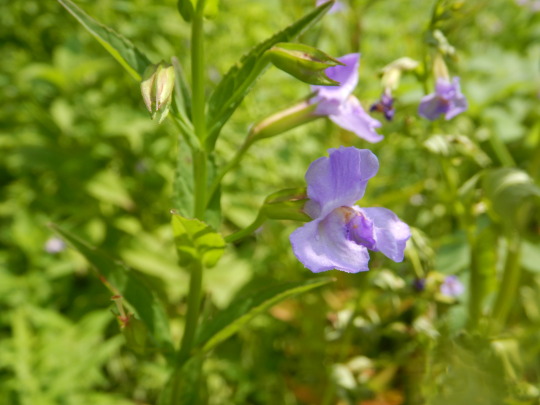
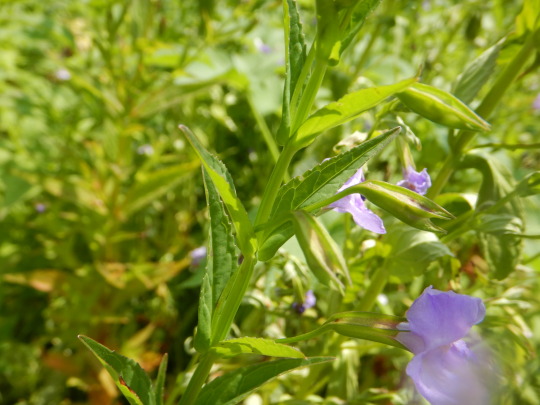
More from the gravel bars and mudflats, a type of riparian ecosystem of the Little Miami pt 2
Mimulus ringens, previous post had the other common species in this, these pictures show just how much larger the peduncle is comparative.
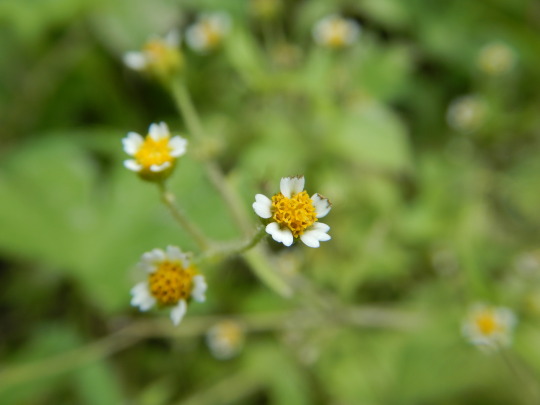

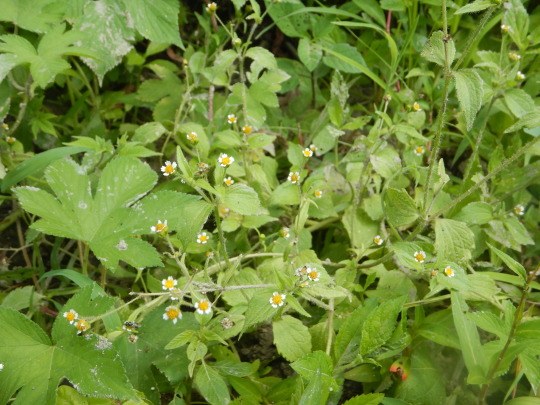
In a patch of Korean hops lies an introduced naturalized species known as Galinsoga quadriradiata or the shaggy soldier. (on broken bar)

Phyla lanceolata, lance leaf fog fruit , If your from Ohio we call it Frog Fruit; a native species perfect for bioswale planting and riparian restoration. Great stabilizer.
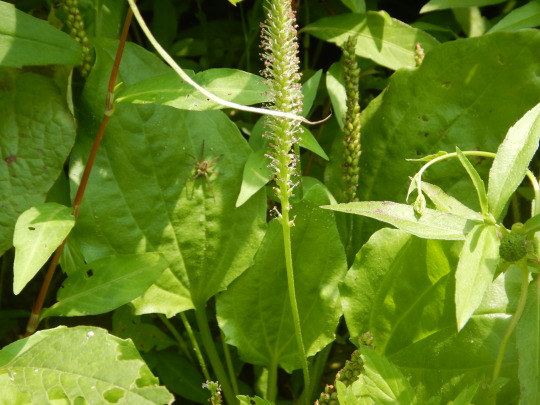

^bottom pic from MN wildflower blog. via Peter M. Dziuk
in the mudflat, Plantago rugelii (fairly sure based off of red base) or the floppy red based broad leaf plantain. If you find a plantain in a mudflat, it usually is stick like or narrow leaved with really unique flower structure that is more bristly looking on average, these tend to be our natives, Heartleaf is more of a gravel scour and flat wet wood species. Much like heart leaf, rugel's also has a broadleaf compared to the rest of the wet loving species. The base of this plant were barely red and the flower morphology was very bristle like is why I think the ID is correct, plus the niche affiliation; with this said, the P. major is also a generalist and can have red when stressed by summer heat on it's petioles so it would of been better to go off of the bulb like base instead of the intuition while kabrewing on the Little Miami. The other way to tell is that the ovules stick more erect.



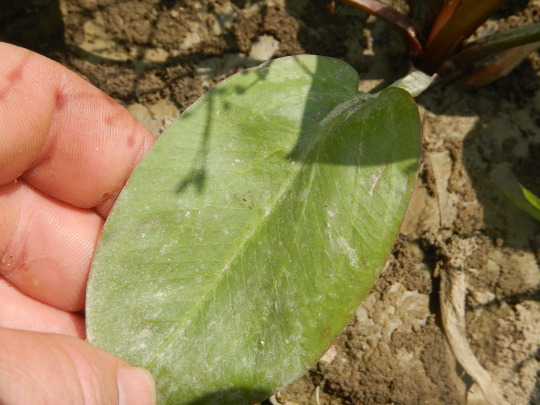


Alisma spp. or rather I think it's A. triviale is a common mudflat species that can take longer partial submersion but doesn't like extended turbulence. Heart leaved small flowered northern water plantain.
#ohio#botany#wildflowers#mimulus ringens#mimulus#galinsoga#galinsoga quadriradiata#phyla lanceolata#phyla#alisma#alisma triviale#plantago rugelii
83 notes
·
View notes
Text

Monkeyflower GNGT South Bay 04/2024
15 notes
·
View notes
Text


@kiweetree / ig zroe.zroe
3 notes
·
View notes
Text

#monkey flower#mimulus#watermelon poppies#california poppies#eschscholzia californica#california native plants#van nuys
0 notes
Text



Tooth-leaved Monkeyflower...
249 notes
·
View notes
Text
My Garden Flowers Part 1
Just thought I'd give you all the garden tour. :) I will update when I get more photos. This is of course not counting any of my ferns or conifers as they don't flower. I might do a series of foliage posts, though. All photos mine, unedited.












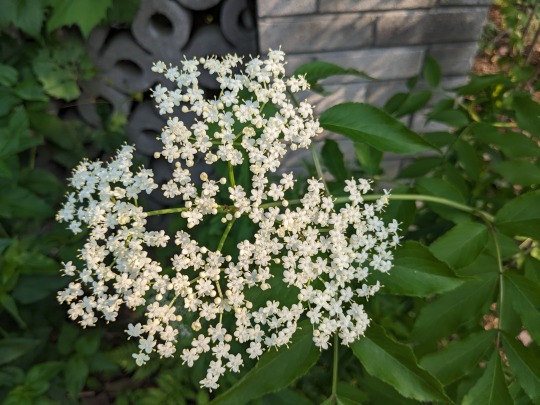

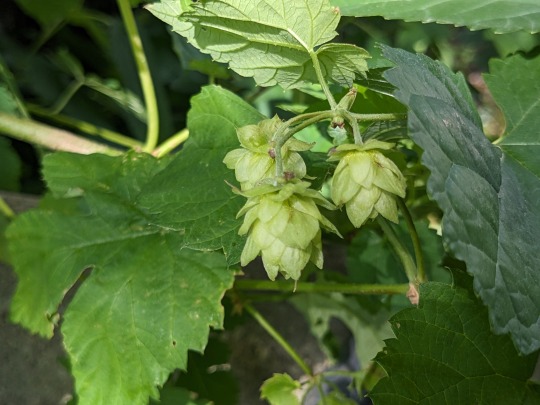


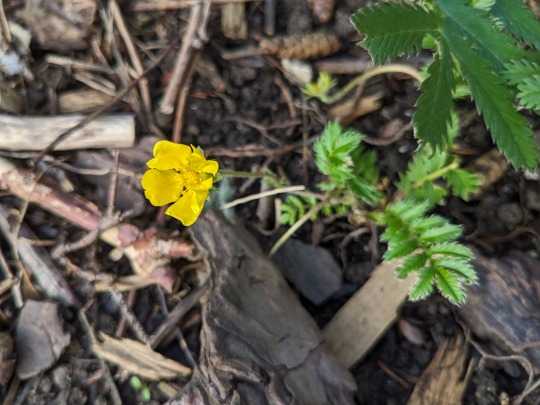

In order of appearance:
001. Canada Plum (Prunus nigra) Not pictured as she hasn't flowered yet. I have her in a shady spot and she's fairly slow-growing but healthy.
002. Yellow Monkeyflower (Mimulus guttata) An annual that sadly doesn't seem to have reseeded despite flowering profusely last year. But maybe next year! That happens sometimes.
003. Boreal Yarrow (Achillea millefolia borealis) The place where she is is north-facing so she doesn't get quite as much sun as she'd like, so she can get a bit leggy but she still flowers so it's fine.
004. Canada Goldenrod (Solidago canadensis) Not pictured as I haven't got any pictures yet, but I will if she flowers this year. I actually had to move her because she had planted herself in a not ideal location in my garden. Which is fine because I wanted one anyway.
005. Vierhapper's Aster (Aster alpinus vierhapperi) This was supposed to be Canada goldenrod, but it's okay because Canada goldenrod planted herself. I relocated her to the intended spot and they get along fine together. Asters and goldenrods generally do. :)
006. Common Sunflower (Helianthus annuus) I did not plant this! Must have been given to me by a bird or squirrel. Sadly she didn't reseed. Oh well, she's a cultivar and I did get the wild type. Interesting to me that she actually flowered in that area when her cousin stubbornly refuses to.
007. Obedient Plant (Physostegia virginiana) This refers to the fact you can move the flowers around, not to the behaviour of the plant, which is very aggressive.
008. Black Chokeberry (Aronia melanocarpa) Not pictured as she hasn't flowered yet.
009. Enchanter's Nightshade (Circaea lutetiana) I didn't plant her; she just started coming up everywhere when I removed the grass. She is not a nightshade. I've learned that even people interested in planting natives regard her as a weed. I disagree. She's not aggressive to other plants and she's pretty.
010. Northern Gooseberry (Ribes oxyacanthoides) Not pictured as she hasn't flowered yet.
011. New Jersey Tea (Ceanothus americanus) Haven't tried her for tea yet, but she's a lovely little bush.
012. Sunchokes (Helianthus tuberosa) Aforementioned cousin of the common sunflower. Not pictured as she keeps making her flowerbuds too late in fall so the frost gets them before they can open.
013. Potato Bean (Apios americana) Not pictured as she hasn't flowered yet.
014. Common Milkweed (Asclepias syriaca) SUPER fragrant, especially in the evening. This is an aggressive plant but worth it for the flowers, the fragrance, and the butterflies they attract. Not to mention the young shoots, flower clusters, young leaves, and young seedpods are all edible if cooked properly!
015. Northern Bayberry (Myrica pennsylvanica) Not pictured as she hasn't flowered yet. Her leaves are nice and evergreen, though.
016. Virginia Strawberry (Fragaria virginiana) Also known as "wild strawberry", but so is her cousin. She flowers reliably every spring but no strawberries yet. The flowers themselves are edible but I keep hoping she'll make strawberries. lol
017. Nannyberry (Viburnum lentago) Not pictured as she hasn't flowered yet.
018. Riverbank Grape (Vitis riparia) Not the greatest picture, but the point is I will get grapes one of these years!
019. False Sunflower (Heliopsis helianthoides) It was hard to pick a favourite photo. They're really quite stunning. She blooms from July until the frosts of October. :)
020. Canadian Serviceberry (Amelanchier canadensis) Not pictured as she hasn't flowered yet. She's a wee little tree in the shade for now.
021. New England Aster (Symphyotrichum novae-angliae) Probably the most attractive of the Symphyotrichum asters, to be honest. The flowers are more compact than most of her relatives while still being a decent size, and the colour is much more saturated too. And the bees absolutely love her. But that doesn't stop me enjoying other asters!
022. Common Elder (Sambucus canadensis) She almost died when I potted her for the move. See I dug up as much of her taproot as I could, but she'd already gone quite deep and I had to break it. But she lived! She's quite big now and has these wonderful lacy white elderflowers every year, with elderberries to follow.
023. Coralberry (Symphoricarpos orbiculata) Not pictured as I didn't get any pictures yet. Should have when I first got her. She was in flower then. She hasn't since.
024. Black Raspberry (Rubus occidentalis) Not pictured as I don't have pictures yet. Don't know why. lol I've taken pictures of the berries. I'll remember next year.
025. Fox Geranium (Geranium robertianum) A true geranium I managed to trade for last year. You mostly find these in the woods and now I have her in my garden.
026-027. Common Hops male and female flowers (Humulus lupulus) I can't remember which is which, but yeah! I could flavour beer if I was a brewer. :)
028. American Spikenard (Aralia racemosa) Another one with lacy little white flowers, and it looks like some of them are going to fruit!
029. Silverweed (Argentina anserina) After several failed attempts, this one has finally taken off. Truly lives up to her name in the spring and has these nice yellow flowers later on.
030. Hoary Vervain (Verbena stricta) The name must refer to the leaves, which are kind of blue-grayish, because the flowers are just a nice purple.
#blackswallowtailbutterfly#my photos#photography#my garden#garden flowers#native plant gardening#native flowers of Carolinian Canada and USA#Mimulus guttata#Achillea millefolium borealis#Aster alpinus vierhapperi#Helianthus annuus#Physostegia virginiana#Circaea lutetiana#Ceanothus americanus#Asclepias syriaca#Fragaria virginiana#Vitis riparia#Heliopsis helianthoides#Symphyotrichum novae-angliae#Sambucus canadensis#Geranium robertianum#Humulus lupulus#Aralia racemosa#Argentina anserina#Verbena stricta
14 notes
·
View notes
Text
Hello there Mimulus Wallenstein / Laugh Maker fans.

0 notes
Video
Calico Monkey Flower(Mimiulus Pictus) by Sandy Steinman Via Flickr: Regional Parks Botanic Garden in Tilden Park in Berkeley, CA
1 note
·
View note
Text


Kitty in a log + white monkeyflower (Mimulus bifidus) from today
106 notes
·
View notes
Text
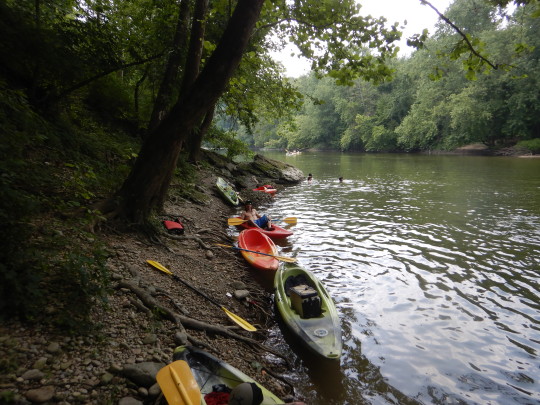

Along the Little Miami Inbetween hamilton and clermont co is a section that maintains conglomerate mudstone layer and a lot of mud banks close enough to mudflats that you still get some classic mudflat species and riparian gravel bar species.

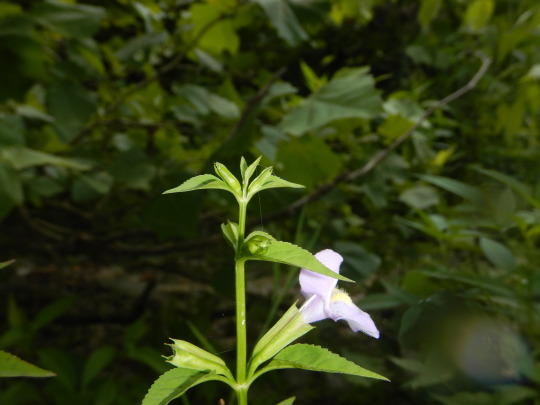
The first is the winged monkey flower(Mimulus alatus) , known for winged squared of stems, though since Ohio gets both, if you need to collect seeds for bioswale forbes and want to differentiate them when the stem is brown, the peduncle, aka main stem that holds/bares a flower or a fruit attached to the stem, is almost sessile or near sessile, aka still there but close to not existing where as Allegheny is elongate.


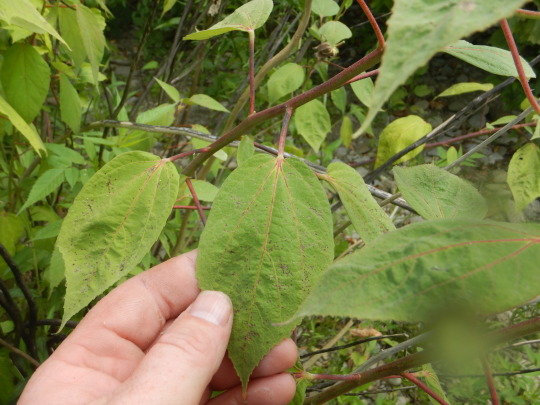
a gravel bar species requiring full sun is Hibiscus moscheutos or the swamp rose mallow, it's about as common as our other native Hibiscus laevis or the halberd leafed mallow; this species pictured has more common smaller colonies with pink flowers on average with what most assume as a non deeply lobed leaf differing from a halberd lobed white flower with taller plants on average and larger colonies.

Wouldn't be a good gravel bar without falls redest sedum, Ditch stone crop! or is it a sedum really???, while we used to assume based on morphological features it is no longer placed in the genera Sedum and is Penthorum sedoides a non succulent water loving species that actually has found it's self as a member of the saxifrage order. It is one of two species that I know of in the genera, and is associated with it's own family as of now. It is also the only member of the genus within the United States. Side note: As a member or the saxifrage order I don't even know if this species utilizes CAM to be honest and it wouldnt benefit it if you think about it.
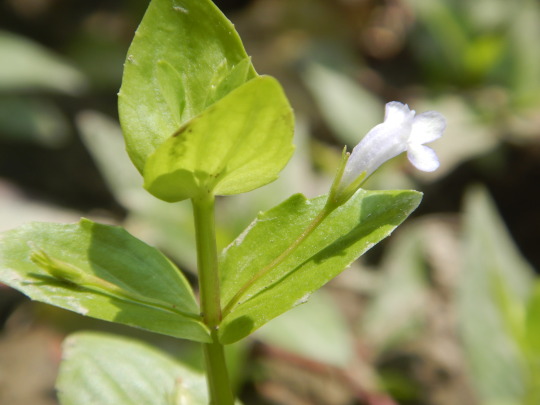
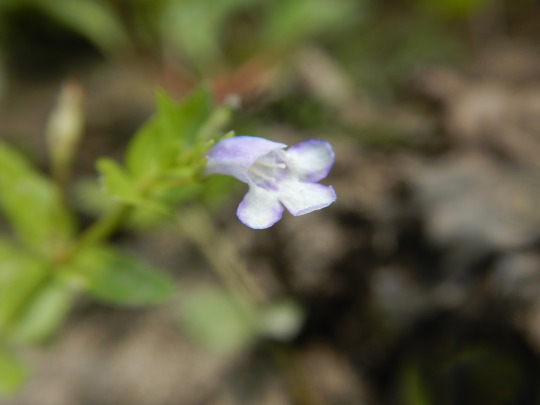

Lindernia dubia
false pimpernel
Associated with the mudflats, it's funny because people call this and many others the mudflat ephemerals because they are brief and seasonal inbetween flood stages. These always look like a monkey flower at first glance before you know the species.
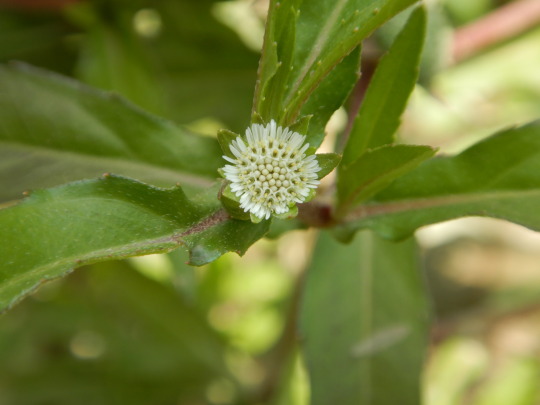
Eclipta prostrata
Mudflat false daisy, a riparian and swale species but also very common on mudflats.
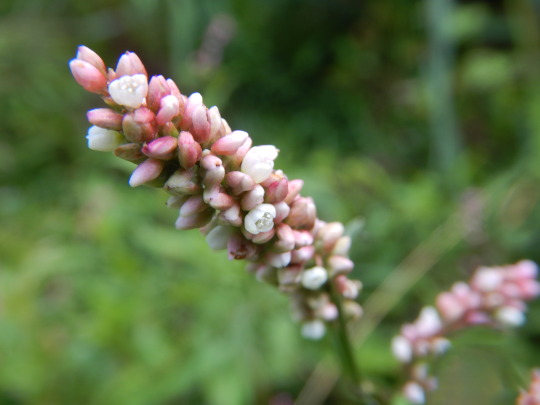
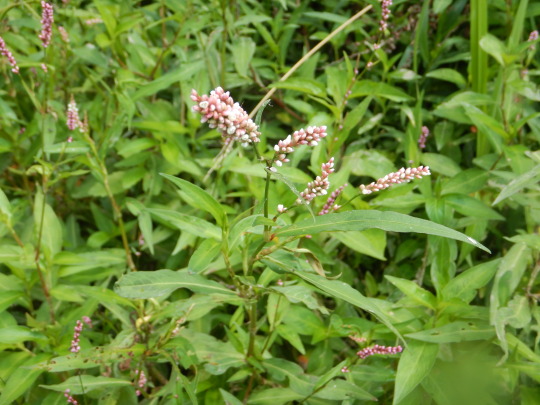


Persicaria pensylvanica or pensylvania smart weed, is a robust flowering species that forms semi erect inflorescence that are peppered pink and white. and easy to differentiate when you look at a non frimbrate connected ocrea that sheathes both stem and petiole. you can see invasive Persicaria longiseta or oriental bristled ladies thumb with frimbrate ocrea in background :( spicy flowers on our natives less spicy on the non natives.
#mimulus#mimulus alatus#ringens#botany#ohio#mudflats#riparian#hibiscus moscheutos#hibiscus laevis#hibiscus#lindernia dubia#lindernia#mudflat#ephemeral#penthorum#penthorum sedoides#eclipta prostrata#Persicaria pensylvanica
23 notes
·
View notes
Text
Writing Notes: Flower Remedies

Flower remedies are specially prepared flower essences, containing the healing energy of plants. They are prescribed according to a patient’s emotional disposition, as ascertained by the therapist, doctor, or patients themselves.
THE 38 BACH REMEDIES
agrimony: puts on a cheerful front, hides true feelings, and worries or problems
aspen: feelings of apprehension, dark foreboding, and premonitions
beech: critical, intolerant, picky
centaury: easily comes under the influence of others, weak willed
cerato: unsure, no confidence in own judgement, intuition, and seeks approval from others
cherry plum: phobic, fear of being out of control, and tension
chestnut bud: repeats mistakes, does not learn from experience
chicory: self-centered, possessive, clingy, demanding, self pity
clematis: absent minded, dreamy, apathetic, and lack of connection with reality
crab apple: a ‘‘cleanser’’ for prudishness, self– disgust, feeling unclean
elm: a sense of being temporarily overwhelmed in people who are usually capable and in control
gentian: discouraged, doubting, despondent
gorse: feelings of pessimism, accepting defeat
heather: need for company, talks about self, and concentrates on own problems
holly: jealousy, envy, suspicion, anger, and hatred
honeysuckle: reluctance to enter the present and let the past go
hornbeam: reluctant to face a new day, weary, can’t cope (mental fatigue)
impatiens: impatience, always in a hurry, and resentful of constraints
larch: feelings of inadequacy and apprehension, lack of confidence and will to succeed
mimulus: fearful of specific things, shy, and timid
mustard: beset by ‘‘dark cloud’’ and gloom for no apparent reason
oak: courageous, persevering, naturally strong but temporarily overcome by difficulties
olive: for physical and mental renewal, to overcome exhaustion from problems of long–standing
pine: for self–reproach, always apologizing, assuming guilt
red chestnut: constant worry and concern for others
rock rose: panic, intense alarm, dread, horror
rock water: rigid–minded, self–denial, restriction
scleranthus: indecision, uncertainty, fluctuating moods
star of Bethlehem: consoling, following shock or grief or serious news
sweet chestnut: desolation, despair, bleak outlook
vervain: insistent, fanatical, over–enthusiastic
vine: dominating, overbearing, autocratic, tyrannical
walnut: protects during a period of adjustment or vulnerability
water violet: proud, aloof, reserved, enjoys being alone
white chestnut: preoccupation with worry, unwanted thoughts
wild oat: drifting, lack of direction in life
wild rose: apathy, resignation, no point in life
willow bitter: resentful, dissatisfied, feeling life is unfair
The system consists of 38 remedies, each for a different disposition.
The basic theory is that if the remedy for the correct disposition is chosen, the physical illness resulting from the present emotional state can then be cured.
There is a rescue remedy made up of 5 of the essences—cherry plum, clematis, impatiens, rock star, and star of Bethlehem—that is recommended for the treatment of any kind of physical or emotional shock.
Therapists recommended that rescue remedy be kept on hand to help with all emergencies.
Flower remedies are more homeopathic than herbal in the way they work, effecting energy levels rather than chemical balances.
They have been described as ‘‘liquid energy.’’
The theory is that they encapsulate the flowers’ healing energy, and are said to deal with and overcome negative emotions, and so relieve blockages in the flow of human energy that can cause illness.
Edward Bach was a graduate of University College Hospital (MB, BS, MRCS) in England.
He left his flourishing Harley Street practice in favor of homeopathy, seeking a more natural system of healing than allopathic medicine.
Concluded that healing should be as simple & natural as the development of plants - nourished & given healing properties by earth, air, water, and sun.
Bach believed that he could sense the individual healing properties of flowers by placing his hands over the petals.
His remedies were prepared by floating summer flowers in a bowl of clear stream water exposed to sunlight for three hours.
He developed 38 remedies, one for each of the negative states of mind suffered by human beings, which he classified under seven group headings: fear, uncertainty, insufficient interest in present circumstances, loneliness, over-sensitivity to influences and ideas, despondency or despair, and overcare for the welfare of others.
The Bach remedies can be prescribed for plants, animals, and other living creatures as well as human beings.
Originally, Bach collected the dew from chosen flowers by hand to provide his patients with the required remedy.
This became impractical when his treatment became so popular that production could not keep up with demand.
He then set about finding a way to manufacture the remedies, and found that floating the freshly picked petals on the surface of spring water in a glass bowl and leaving them in strong sunlight for three hours produced the desired effect.
Therapists explain that the water is ‘‘potentized’’ by the essence of the flowers.
The potentized water can then be bottled and sold. For more woody specimens, the procedure is to boil them in a sterilized pan of water for 30 minutes.
These two methods produce ‘‘mother tinctures’’ and the same two methods devised by Bach are still used today.
Flower essences do not contain any artificial chemical substances, except for alcohol preservative.
Bach flower remedies and flower essences have not yet officially won the support of allopathic medicine, despite the fact that more and more medical doctors are referring patients for such treatments on the strength of personal conviction.
However, it is difficult to discount the scores of testimonials.
Some practitioners refer skeptics to the research that has been done regarding the ‘‘auras’’ of living things.
Theoretically, the stronger the aura, the more alive an organism is. Flower essences have very strong auras.
Source ⚜ More: Notes & References
#writing reference#writeblr#dark academia#spilled ink#writers on tumblr#literature#writing inspiration#writing notes#writing prompt#poets on tumblr#writing ideas#creative writing#fiction#flowers#remedies#writing resources
154 notes
·
View notes
Text

Lewis's Monkeyflower (Mimulus lewisii) showing off : )
(c) riverwindphotography, July 2023
283 notes
·
View notes
Text















Sunday morning hike at Friendship Hill National Historic Site, after two days of drenching rain that provided some relief from the terrible drought gripping Central Appalachia. I never thought I would be so happy to hear rain droplets smattering on moist leaves again. When the clouds broke above the Monongahela River, it was as if some great spirit had gifted me an impressionists' painting of the earth. Then the oppressive heat returned, and I realized the drought would hang on.
If nothing else, I was enchanted by the gorgeous rose mallow (Hibiscus moscheutos) and whimsical Allegheny monkeyflower (Mimulus ringens) now in bloom along the river's marshy edges. In the deeper woods, the blue cohosh (Caulophyllum thalictroides) is succumbing to summer's heat, but not before leaving behind a gift of iridescent blue berries, shiny like blue porcelain. And the summer boletes have pushed up from the leafy humus of the forest floor with that certain heady perfume only mushroom hunters can love. On a more macabre note, I was mesmerized by a cicada killer (Sphecius speciosus) tackling an unfortunate dog-day cicada (Neotibicen canicularis), which is an annual rather than a periodical cicada. The cicada continued to buzz dutifully as the giant wasp prepared to paralyze it and fly it off to her nest to be eaten alive by her larvae. The wasp literally has to drag that cicada, which is twice her size, up a tree to gain sufficient altitude to take flight. Fortitude and dedication.

As an aside, I was amused by a recent story about some residents of the Pacific Northwest losing their shit over sightings of giant Asian "murder" hornets, only to be informed the presumed felons are native cicada killers, which are unaggressive and harmless to human beings. Rather not live in a constant state of fear and paranoia from murder hornets and other villainous wildlife? Download a free field guide instead. :-)
#appalachia#vandalia#pennsylvania#friendship hill national historic site#fort necessity national battlefield#albert gallatin#us history#monongahela river#flora#wildflowers#summer#insects#dog-day cicada#annual cicada#cicada killer#cicada hawk#rose mallow#allegheny monkeyflower#blue cohosh#starry campion#widow's frill#whorled catchfly#mussel#fungi#bolete
37 notes
·
View notes
Text
Snapshots from the garden: March 2025
Despite the post date, this is not - I repeat, not - an April Fools' day post. I just had some garden progress photos I wanted to share.

Plant previously identified as “jasmine, probably” has been upgraded to “jasmine, definitely", as anyone within ten feet of it can inform you.


The California natives I planted last summer - foolishly, in the heat and the dry - have finally come into their own. Verbena lilacina, ‘De La Mina’ (left) went from six inches to two feet across when its flowers arrived, and Ceanothus ‘Dark Star’, which had a tough start in life, is in flower too.
I worried a lot in January or February about spring bulbs, which need a period of chill ("vernalization") to bloom properly, which our warm climate tragically just can't provide -
Never mind! Daffodil ('Apricot Whirl'), hyacinth ('Grapefruit Mix'), and muscari ('Delft Blue Mix'): all bloomed despite receiving only a few weeks in the fridge. The hyacinth received no time in the fridge, actually; I planted it prematurely in my excitement right after buying it, and actually lost it in the dirt, right up until it sprouted and bloomed.


February-planted ranunculus (‘Tecolote Merlot’) and anemone ('Monarch de Caen Mix') have just started to make a showing, as expected:


And natives:


Monkeyflower, 'Jelly Bean Brick' and blue-eyed grass.


Almost my entire incipient orchard broke dormancy this month, including the newly-planted bare roots. This is an early bloom from 'Strawberry Free' peach branch on a new multibud peach tree, and baby leaves on Zanthoxylem simulans, the Sichuan peppercorn tree. Note how the leaf clusters emerge right near the thorns.

This hybrid Mimulus naiandina “Mega”, has such stupidly huge and showy flowers, I mistook it for a stray foxglove at first. Purchased from Annie’s Annuals - now Curious Flora Nursery - in Richmond, which is a garden wonderland and I highly recommend a visit if you’re in the area.
See? No tricks in this post. Just the last of this winter's camellias--

-- Hah, got you. I bet you feel silly now that I've made you look at a surprise photo of my cat!

8 notes
·
View notes
Text


Diplacus aurantiacus
This species, commonly known as the sticky monkey-flower, is a very common plant in California, but the usual color is pale orange. The white form, with a little yellow in the throat, is a delightful change of pace. Known for many years as Mimulus aurantiacus (and placed in the family Scrophulariaceae), it has been re-named as Diplacus aurantiacus and put in the family Phrymaceae.
-Brian
18 notes
·
View notes
Text
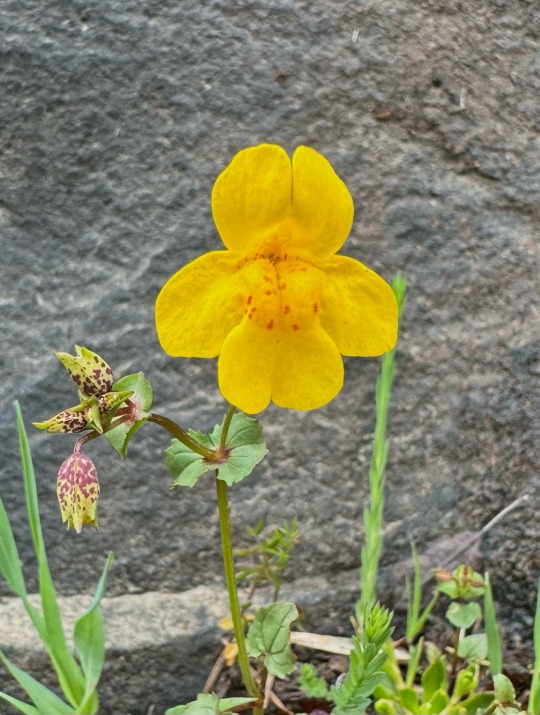
Seep-spring Monkeyflower..
226 notes
·
View notes